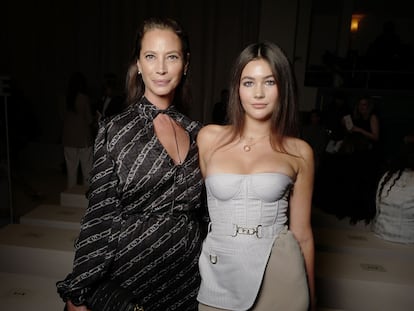Linda Evangelista: ‘My goal now is to get old. I want to get old, really old’
The top model has survived two cancers, an ex-husband who she accuses of abuse and a failed surgery. Now she returns to release a glossy volume of her work with photographer Steven Meisel
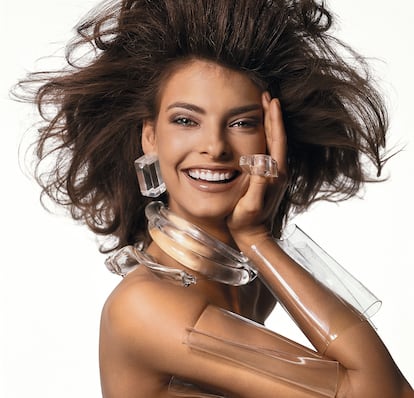
“Divine” is Steven Meisel’s favorite word. The legendary fashion photographer uses it often and without irony, especially when a model executes a perfect gesture. For Meisel, an expert in capturing those moments, it is the highest compliment. And supermodel Linda Evangelista has received it more than anyone else. The union of these two artists is a thing of legend, at least within the confines of fashion and photography. For almost four decades, they have created unorthodox portraits and influential fashion editorials.
Some of the photos can be seen in the ambitious exhibition 1993: A Year in Photographs, which the Fundación MOP dedicated to Meisel in A Coruña, Galicia, in May of this year. But now the photographer’s work with the top model has been released in the book Linda Evangelista Photographed by Steven Meisel, a volume published by Phaidon that reviews the duo’s most transcendental moments. For many, it is the fashion book of the year. “It’s incredible,” says Evangelista, cup of coffee in hand, from Milan. “It’s crazy. I look at a photo and the memory of that day returns to me in an instant. I turn the page and I feel like another person is looking at me. Who’s that? The variety of what we’ve done and the range of our work, even though it doesn’t follow any order, makes me proud.”
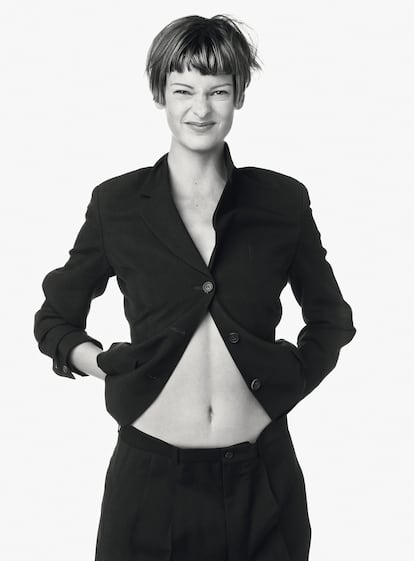
If Meisel is the master of narrative in fashion photography, a talent beyond good and evil, she is the model who will go down in history for her ability to transform into whatever he wants: a Marilyn-style diva, a renaissance page or a modern Katharine Hepburn. “Both of us love what we do and we’re really dedicated,” the model explains. “But something made us get along from day one. It was love at first sight. We communicate without talking. With the way that Steven tilts his head or looks into my eyes, I know exactly what to do. I’m not afraid at all to try something new and experiment. And I trust that with him it will never turn out wrong,”
Evangelista has returned to the front lines after a few years far from the spotlights. She shows off recent fashion campaigns, an Apple TV documentary series, Vogue covers and, now, the book. Today the model, one of the original supermodels that marked the nineties, is once again seeing her moment. She is having a rebirth, and her fans encourage her to keep going. “I could cry,” she says, while she attempts to hold back tears. “The love I’ve experienced is overwhelming and it makes me so happy. It’s healing me.”
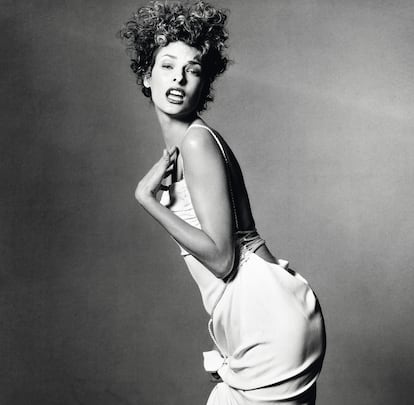
From what? To start, from the trauma of a failed cosmetic surgery that, in her words, “permanently and brutally disfigured” her. The technique, called CoolSculpting, is intended to eliminate localized fat, but for Evangelista, it caused the opposite: paradoxical adipose hyperplasia, or an increase in her body’s fat cells. She hid from the world until she couldn’t any longer. “I was very sad, but I was tired of isolating myself. I didn’t have anyone to go to who had gone through the same thing, and I couldn’t even find anything on the internet about it. Now more cases have been reported and I see that many people have gone through the same thing. Then I got breast cancer again [she had it twice in five years and had a double mastectomy], so I needed intimacy. But I didn’t want to whine or be sorry for myself. For me, there was always light at the end of the tunnel, so I waited,” she says now.
‘I’m a fighter, though I haven’t had a choice. I’ve gone through a lot of operations in my life and throughout my career, but I want to live. When I think of fashion and the fact of being able to make images, I see it also as a way to escape my real life. I assumed that things don’t always come out as they’re planned.” The key to the new Evangelista is that she’s not trying to repeat her past: the eternal chameleon has embraced her own story with the aplomb with which she used to wear thousands of masks. And she has been more successful than she expected. She spent the week before our interview descending from limousines to sign books, accompanied by her son —her spitting image— and with the radiant appearance of an Italian neorealist diva in all her mature splendor.
The morning that we spoke, she had flown to Italy to attend a Fendi test with designer Kim Jones. (Days later, she was the star of the runway show, dressed in an imposing sky-blue jacket.) The model says she’s excited. She appears slightly stunned by all the attention. But despite her nerves, there has a luminous elegance and an innate self-confidence in the star who in 1978 won her first contest —Miss Niagara— at only 12 years old.
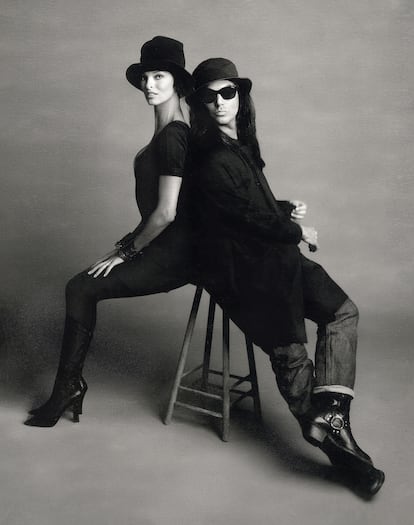
Her stratospheric success exploded in the nineties alongside her colleagues Cindy Crawford, Naomi Campbell and Claudia Schiffer. They were the first models to become as famous as pop stars. At the height of her fame and beauty, George Michael called her to star in two music videos. In 1992′s “Too Funky,” the Canadian played an exaggeratedly kitschy version of herself.
When she wanted to escape, Evangelista retreated to Casa Linda, her elegant refuge at the top of an Ibizan hill, which she bought with her modeling earnings but which no longer belongs to her. “Yes, I lost that house. The man I was married to forced me to leave it,” she states drily. She refers to Gérald Marie, the fashion titan accused of rape who was the head of Elite Models, Evangelista’s agency. She accuses him of abuse and says that if Marie didn’t touch his face, it is because it was “his source of income.” The ex-agent has denied the accusations from Evangelista and other women who have denounced him. (The French justice system closed the investigation in February because the crimes’ statute of limitations had expired.) But Evangelista doesn’t forgive him. “Don’t bring that up,” she says, visibly upset. “You can put this in writing: he has that house now, but it is mine. I paid for it.”
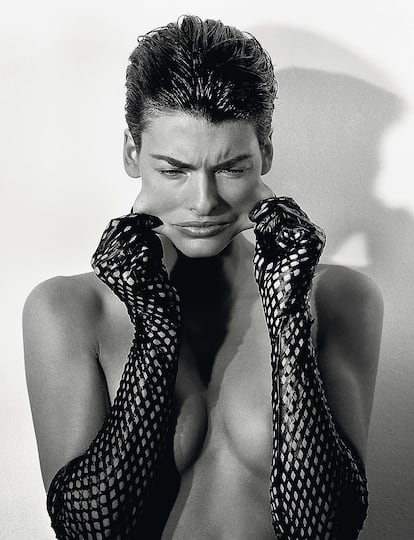
During the nineties, I ran into Evangelista on all sorts of occasions, at parties, weddings and funerals. Always discreet and humble, though she represented the decade as much as Bill Clinton or Bart Simpson, the miracle occurred on the catwalk or before the camera. I witnessed it in winter 1994 in New York as she shot an editorial for Harper’s Bazaar with David Sims. Manhattan was covered with snow, and she entered the studio dressed for an Arctic fantasy, wrapped in a bulky Isaac Mizrahi fur. Half an hour later, she left the dressing room in a toupee, sheathed in a Yves Saint Laurent tuxedo, transformed into another person. “She was brilliant,” Sims says. “She had an extraordinary capacity to channel characters. She is a perfectionist, a fashion expert that knows the references, knows what it’s all about and puts in more effort than anyone else to capture a moment. Whatever the photographer or stylist wants, she gets it. Always.”
Luis Venegas, director of the publications Candy and Fanzine137, insists that the model’s signature has always been her talent to reinvent herself over and over. “Madonna talks about herself as the queen of reinvention, but I think Linda was first. Her images were always alive. She seemed to say: who are we going to be today? Am I Lucille Ball or a grunge girl?” With those credentials, has she ever thought about acting? “No, that was never my dream. There are models who go down that path and do incredible things, like Charlize Theron, but it never seemed like the right thing for me. It wasn’t where I wanted to go. It’s not that I was opposed to it, but it just didn’t happen. My head wasn’t there.”
In a world where youth seems to be everything, Linda Evangelista isn’t afraid of getting old. In fact, it’s the interview question she most easily responds to: “My sector has done a pretty good job with becoming more inclusive,” she declares. “With respect to body types, age and skin color. Now it’s much more tolerant than before.” And how does she see herself in the near future? “My goal now is to get old,” she announced. “That’s what I want to do. “I want to get old. Very, very old.”
Sign up for our weekly newsletter to get more English-language news coverage from EL PAÍS USA Edition
Tu suscripción se está usando en otro dispositivo
¿Quieres añadir otro usuario a tu suscripción?
Si continúas leyendo en este dispositivo, no se podrá leer en el otro.
FlechaTu suscripción se está usando en otro dispositivo y solo puedes acceder a EL PAÍS desde un dispositivo a la vez.
Si quieres compartir tu cuenta, cambia tu suscripción a la modalidad Premium, así podrás añadir otro usuario. Cada uno accederá con su propia cuenta de email, lo que os permitirá personalizar vuestra experiencia en EL PAÍS.
¿Tienes una suscripción de empresa? Accede aquí para contratar más cuentas.
En el caso de no saber quién está usando tu cuenta, te recomendamos cambiar tu contraseña aquí.
Si decides continuar compartiendo tu cuenta, este mensaje se mostrará en tu dispositivo y en el de la otra persona que está usando tu cuenta de forma indefinida, afectando a tu experiencia de lectura. Puedes consultar aquí los términos y condiciones de la suscripción digital.
More information
Archived In
Últimas noticias
Most viewed
- Sinaloa Cartel war is taking its toll on Los Chapitos
- Oona Chaplin: ‘I told James Cameron that I was living in a treehouse and starting a permaculture project with a friend’
- Reinhard Genzel, Nobel laureate in physics: ‘One-minute videos will never give you the truth’
- Why the price of coffee has skyrocketed: from Brazilian plantations to specialty coffee houses
- Silver prices are going crazy: This is what’s fueling the rally

